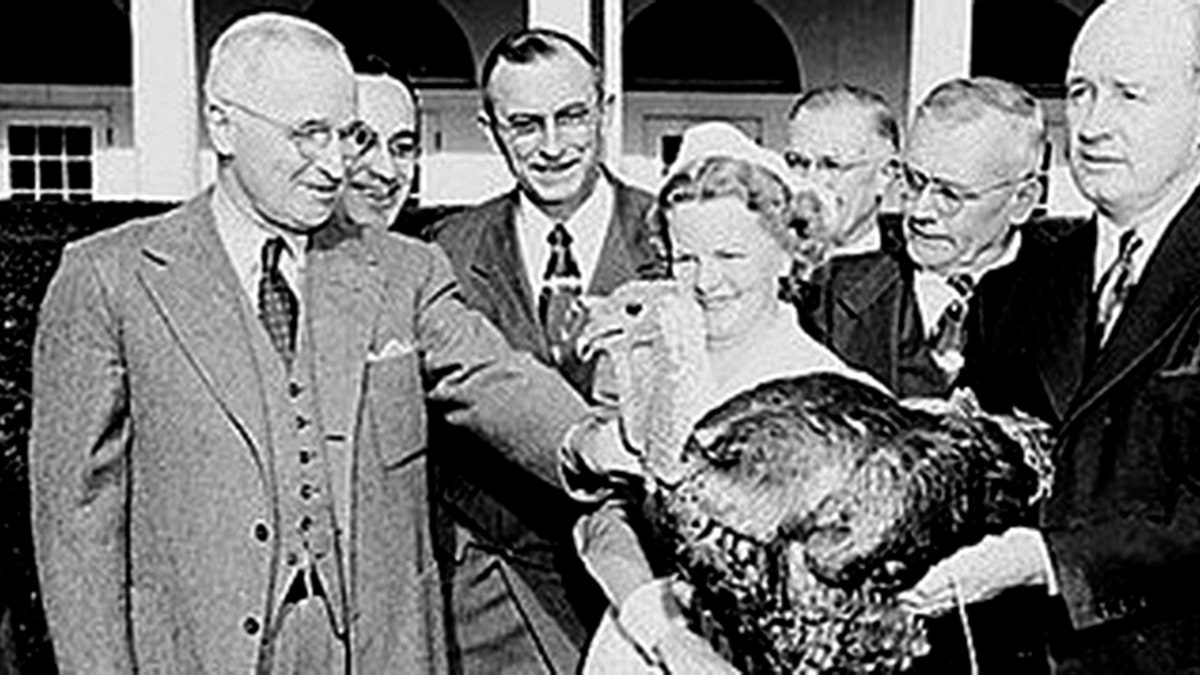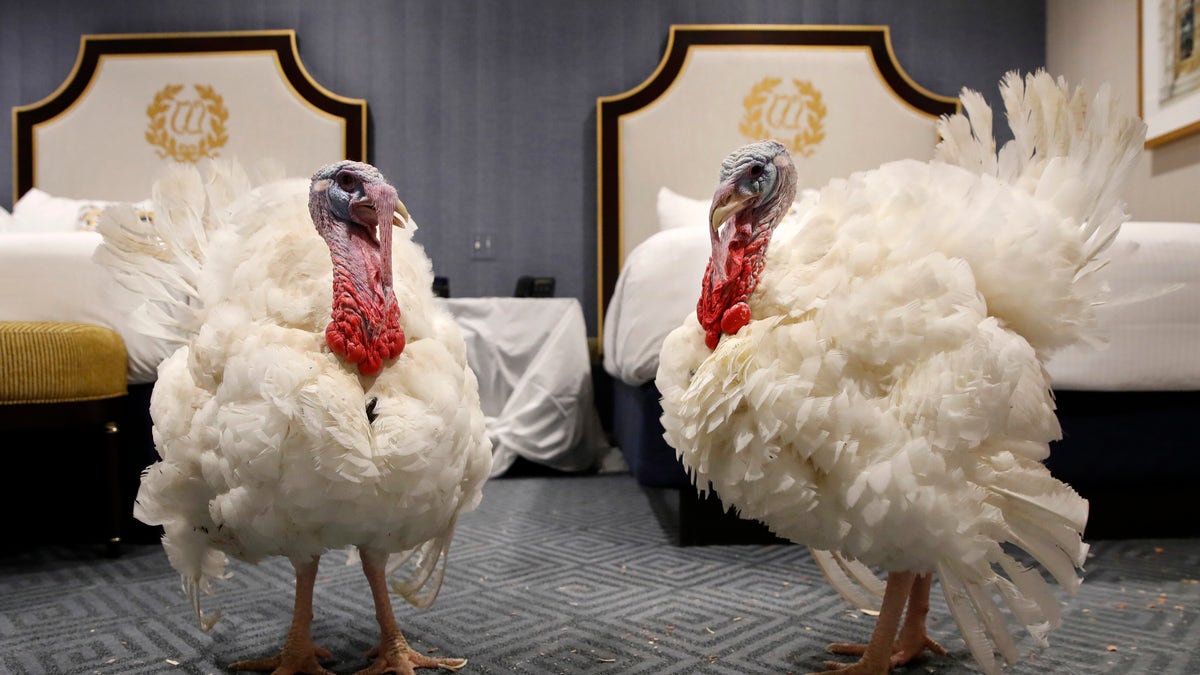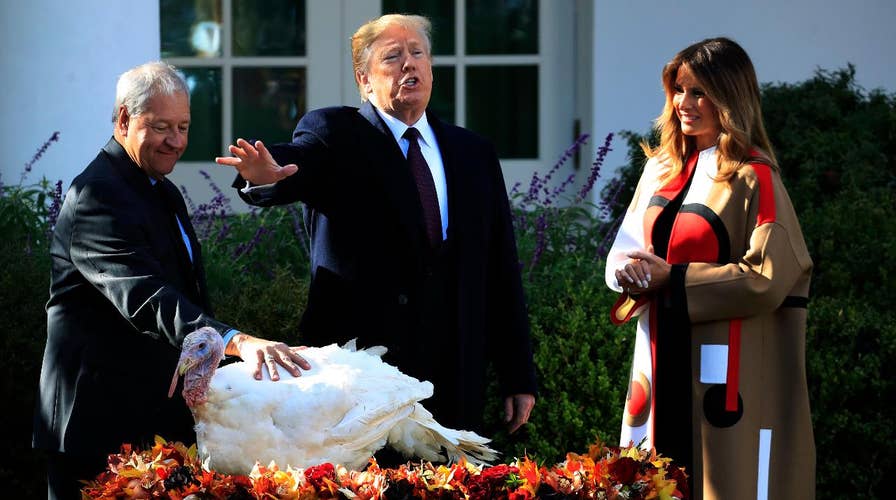Trump pardons Thanksgiving turkeys Peas and Carrots
President Trump and first lady Melania Trump host annual presidential turkey pardoning ceremony in the Rose Garden.
It’s a big day to be a tom.
President Trump used his presidential pardoning power to grant mercy to Peas, one lucky bird, at the White House Tuesday. A fairly new tradition, the event spares one turkey from dinner just two days before Thanksgiving, the biggest turkey-eating holiday all year.
After the public voted, Peas emerged the winner and was pardoned by Trump. Carrots, too, was spared by the president.

President Donald Trump pardons Peas as he and first lady Melania Trump participate in a ceremony to pardon the National Thanksgiving Turkey in the Rose Garden of the White House in Washington, Nov. 20, 2018. (AP Photo/Carolyn Kaster)
How did the tradition start?
Although there’s much speculation over just who was the first president to actually pardon the poultry, experts – including the National Turkey Federation (NFT) – credit former President George H.W. Bush for starting the official tradition.
“The formalities of pardoning a turkey jelled by 1989, when George H. W. Bush, with animal rights activists picketing nearby, quipped, ‘But let me assure you, and this fine tom turkey, that he will not end up on anyone's dinner table, not this guy – he's granted a presidential pardon as of right now – and allow him to live out his days on a children's farm not far from here,’” the White House Historical Society says.
The custom of sending turkeys to the White House is an old one – dating back to the 1870s when “poultry king” Horace Vose would send his birds – but many former leaders of the free world actually ate the turkeys instead of setting them free.
However, some presidents, including Abraham Lincoln and John F. Kennedy, did spare a few fowls in their day.

Former President Harry S. Truman was the first president to receive a turkey from the National Turkey Federation in 1947. (White House archives)
Harry S. Truman, too, was rumored to have saved a few birds in his day, although his presidential library dispelled those claims. Those rumors most likely stem from Truman being the first president to be presented with a turkey by the NFT in 1947. The annual event has been a tradition ever since – although it’s not clear what the fate was for every turkey presented.
How are the turkeys selected?
The NFT’s chairman is elected every February, but official preparations for the annual pardoning begin around July or August, Kimmon Williams, the public relations manager for the federation, told Fox News in a 2017 interview.
This year’s pair – Peas and Carrots – were raised on a farm in South Dakota by NTF Chairman Jeff Sveen and turkey grower Ruben Waldner, according to the White House.
The Presidential Flock are usually toms – males – because of their traditional appearance, strut and gobbling sounds, according to Williams. The pair is picked based on their characteristics, personality and interactions with people, she said.
How do the turkeys prepare for the big event?
The Presidential Flock doesn’t arrive in Washington, D.C. without a little training first. They are “acclimated from an early age to the unique experiences of the ceremony: television lights and crowded noises,” according to the NFT.
Williams said the turkeys, too, will take a tour around their home state ahead of their trip to the nation’s capital, where they will meet with children. This gives the turkeys more of a chance to interact with crowds and unusual noises, and kids an opportunity to experience farm culture.
Where do the turkeys stay once they are in Washington?

Two turkeys from South Dakota, Peas and Carrots, get comfortable in their room at the Willard InterContinental Hotel, after their arrival Nov. 18, 2018, in Washington. Peas was pardoned by President Trump ahead of Thanksgiving. (AP Photo/Jacquelyn Martin)
Ahead of the pardoning, the two turkeys live large.
The turkeys are put up in the Willard InterContinental Hotel in downtown Washington, D.C. – a swanky hotel near the White House. Peas and Carrots checked out of their accommodations on Tuesday.
Don’t worry, taxpayers: the NFT said it covers the cost of the hotel stay.
What’s next for the free birds?

A live turkey is brought into the James S. Brady Press Briefing Room before the media at the White House. (AP Photo/Manuel Balce Ceneta)
After the pardoning, both turkeys will go to Virginia Tech’s “Gobbler’s Rest” where they will be cared for by students and veterinarians. Other birds have been sent to farms and zoos.
The public is welcome to visit Peas and Carrots in Blacksburg, Va., but not for long.
With luck, the Presidential Flock might live another year or more. A few of their predecessors have hit the ripe old age of 2, but very few domestic turkeys live that long. The vast majority get sent to processing plants when they're between 14 to 20 weeks old.
The Associated Press contributed to this report.





